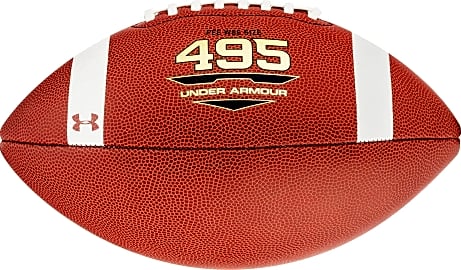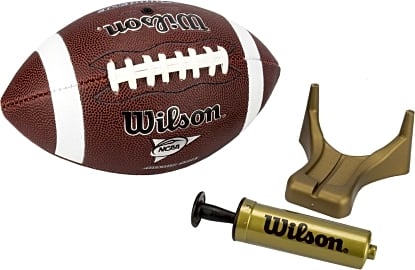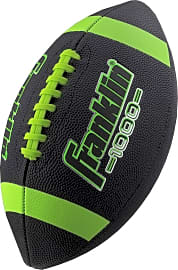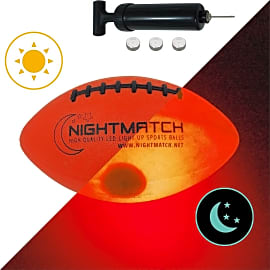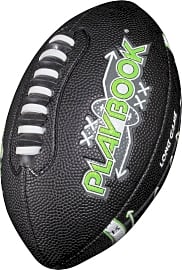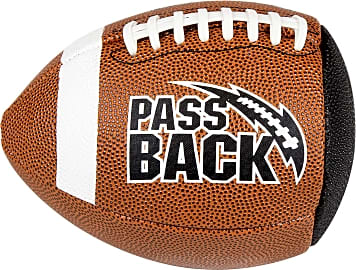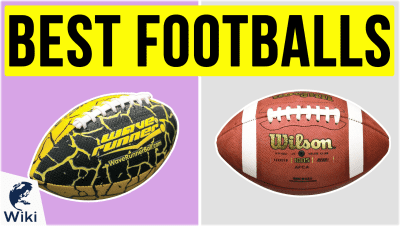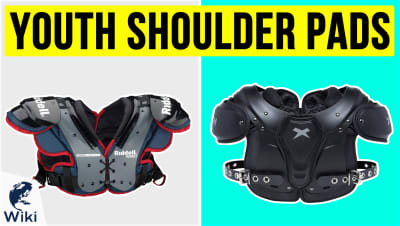The 10 Best Junior Footballs

This wiki has been updated 42 times since it was first published in February of 2016. If your kid is an aspiring NFL player, then one of these junior footballs, some of which are training models, is just what he or she needs. Sized specifically for smaller hands, they are great for practice sessions in the park or for just tossing around for fun in the yard. They're also an excellent choice for adults who find the regulation size pigskin difficult to handle. When users buy our independently chosen editorial choices, we may earn commissions to help fund the Wiki.
Editor's Notes
July 09, 2020:
Considering it is one of America's most beloved sports, it isn't surprising that many kids want to play football. To make the game easier for them though, it is important to get them a junior ball. These are slightly smaller than adult options, so they will fit better in the hands of youths, improving their ability to throw and catch them. Before getting into our reasoning behind including some of the options on our list though, we want to include a quick note about safety. As much fun as football is, it can also cause injury if children aren't wearing the correct protective gear, so make sure to outfit them with a helmet and shoulder pads, even if they are just playing in the park with neighborhood friends.
If you are looking to get your child something that looks and feels just like what the pros use, the Wilson TDJ GST is going to be your best bet. It is made from genuine leather, so it has a nice soft feel, and features a patented Accurate Control Lacing that is pebbled to improve its grip. Though made from PVC rather than leather, the Wilson Touchdown WTF1694 and Wilson NCAA Supreme both look and play like premium footballs as well. They are crafted with butyl bladders too, which are known for their excellent air retention abilities. When it comes to offering a secure grip, we like the Under Armour 495, which has a highly-tacky composite cover and proprietary laces with micro abrasions for extra texture.
While training with a regular ball is great, we have found some options that may be able to speed up the learning curve. For example, the ESPN Future Pro features diagrams that clearly illustrate where to place the hands to throw a perfect spiral, as well as where to kick it when punting or practicing field goals. There is also the Franklin Playbook, which has diagrams of 13 common short and long game routes on it, and the Passback Composite Training, which allows QBs and receivers to practice solo.
For those late evening games, it is important to get something that stands out against a darkening sky, such as the Franklin Grip-Rite 1000, which has bright neon green accents. If planning on playing long past after the sun sets, the NightMatch Light Up is going to be your best option. Give it a quick smack or bounce it off the ground, and it will illuminate for 30 to 40 seconds, which should be enough time for the receiver to catch it.
Special Honors
Football Injury Prevention For both children and adults, it is important to keep safety in mind when playing football. This means more than just wearing the proper protective gear. This website provides valuable information on hydration, stretching, and other things that can help prevent or reduce the chances of injury. orthoinfo.aaos.org
A Brief History Of Football
College stars like Jim Thorpe and Red Grange became household names, and used their fame to bolster the credibility of the newly-formed National Football League.
The dawn of football came in 1869, when Princeton met Rutgers in the first intercollegiate match. The game looked a little different then, given that you could only advance the ball by kicking it and there were 25 players to a side, but the important thing was that the players were allowed to decimate one another. A national pastime — or possibly a religion — was born.
The game would grow in popularity among northeastern schools, eventually leading to a conference in 1875 to codify the rules. However, the resulting changes made by the attendees weren't enough to satisfy a young Yale student named Walter Camp, who was discouraged by the chaotic nature of the nascent sport.
Camp suggested limiting the number of players to 11 per side, as well as establishing a line of scrimmage. His next big idea was to dictate how many attempts you had to advance the ball a certain length of the field. This implementation of down-and-distance became perhaps the most important innovation in American football, narrowly edging out the beer helmet.
Camp's final major contribution was the concept of blocking. This made the game extremely physical — and extremely exciting. As a result, it quickly caught on in the college ranks, spreading across the country by the turn of the century.
There was only one problem: players kept dying. This became such an issue that even President Theodore Roosevelt was forced to weigh in and demand that changes be made.
This led to the creation of the forward pass, which was designed as a way to advance the ball without having to run through someone. Helmets were also soon made mandatory, as were pads designed to make the game safer.
College stars like Jim Thorpe and Red Grange became household names, and used their fame to bolster the credibility of the newly-formed National Football League. However, the NFL would remain considerably less popular than the college game until 1958, when the league's championship game — "the greatest game ever played" — would captivate the entire nation.
Since then, professional football has become arguably the most popular sport in America, with the college version not far behind. The game is still changing — and still criticized for its violence — but it's now hard to imagine an America without football.
Unless, of course, you're a Browns fan. Then it's very easy to imagine.
How To Pick The Right Junior Football
If you want to get your child as hooked by the game as you are, buying them their own football is a good start. Of course, regulation balls are usually too big for young hands, so getting them one that's the right size is a must.
Most younger players aren't very sure-handed, so expect the ball to hit the ground often.
The best way to do this, of course, is to let them handle as many options as possible. Various sizes and materials will have different feels, and the only way to know what they prefer is to ask them. After all, if they don't enjoy throwing it, they're not going to want to play.
If your child is still a little young (or maybe not so coordinated), then finding a softer model should be a priority. You don't want them terrified of getting hit with the thing, so something that can bounce harmlessly off of them will be a good idea. Also, the softer it is, the less likely it will be to jam their little fingers, which is a sure-fire way to end a game of catch prematurely.
Make sure that it can stand up to some abuse, as well. Most younger players aren't very sure-handed, so expect the ball to hit the ground often. You don't want something that will begin to leak or unravel just because it took a few bounces on the concrete.
Ultimately, though, the most important thing is to pick one that they'll actually enjoy throwing. You want them to be comfortable with the ball in their hands — because then they'll never see you coming when you're blitzing off the edge.
The Proper Way To Throw A Football
There are few things more captivating than a football thrown in a tight, accurate spiral — and few things more humiliating than tossing up a wobbly lame duck. Luckily, with these tips, you can show your kid how to be the star of your next Thanksgiving flag football game.
Start by gripping the ball near the back end, with your fingers on the last two or three laces. Many balls have raised laces that allow you to get a better grip, and you'll also need to keep a little air between your palm and the leather.
There are few things more captivating than a football thrown in a tight, accurate spiral — and few things more humiliating than tossing up a wobbly lame duck.
Next, stand with your feet shoulder-width apart, perpendicular to your target. Your knees should be slightly bent, with most of your weight on your back foot.
Once you're ready to chuck it, raise the ball to your ear level. Then, powerfully rotate your hips to open up your body towards your receiver, ending with your front foot pivoted forward and your shoulders square. By the end of the throwing motion, all of your weight should be on your front foot.
Use your non-throwing arm to add torque to this motion, spinning it down and away from the ball. This should bring your throwing hand forward. Use that momentum to propel the ball — most of the effort should come from your hips and torso, not your shoulder.
When you release the ball, spin it with your fingers and end with your thumb pointing down. This is a little counter-intuitive — but it's also how you create a spiral. Follow through with your release until your throwing hand is down near the opposite hip. If done correctly, you should see a tight, perfect spiral.



